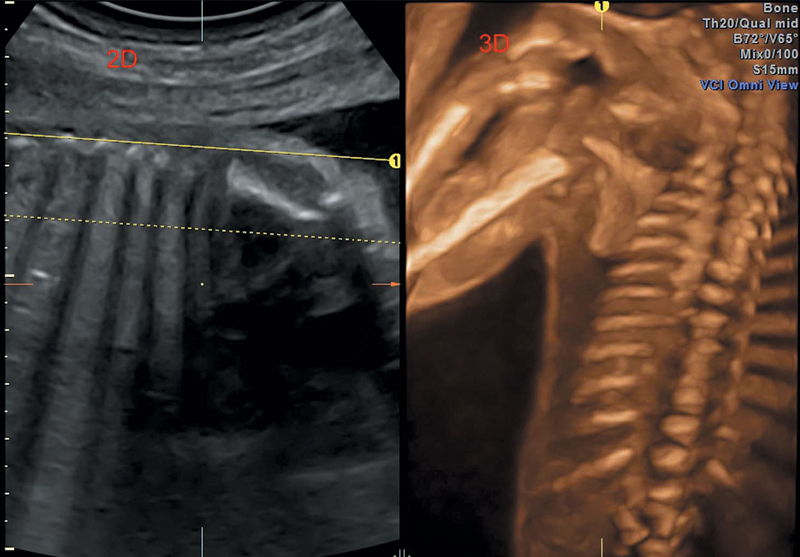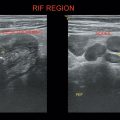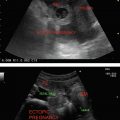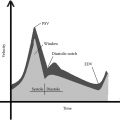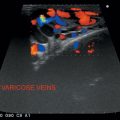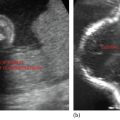Works similar to traditional 2D USG except that ultrasound waves are directed from multiple angles. These waves are reflected back and captured and provide enough information to construct a 3D image.
Advantages
1. Multiplanar
2. High-spatial resolution
3. Less scan time
4. Reproducibility
5. Images can be stored for revaluation
6. Teleconsultation
7. Postprocessing (Tomographic ultrasound imaging [TUI], volume rendering (VR), and automatic slicing)
8. Measurement of volume and vascularity of the lesion
Acquisition
1. Manual (Mechanical scanner)—Probe is moved by the user during data acquisition.
2. Sensor based (Sensed free-hand technique).
Transmitter generates pulsed electromagnetic field, which is detected by the sensor attached to the transducer.
3. Automatic (Free-hand scanning without position sensing).
Anatomy is acquired as a dataset.
Each anatomical scan plane can be rotated on XYZ-axis to get high-quality image.
Indications
Gynecologic—
Congenital uterine malformation.
Characterization of adnexal masses.
Infiltration of adjacent organs.
Volume measurement.
Obstetric (Figure 45.1)—Fetal face, cleft lip, and palate, nuchal thickness, cardiac, skeleton and neural tube defects, and so on.
Saline sonohysterography
Prostate
Tumors
For interventions
Augmenting capabilities for data storage allows extended field of view (EFOV), panoramic imaging.
3D + Time—4D (3D motion video—real-time video of anatomy)
Fast sequences of 3D images are processed real time through 30 frames per second volumetric imaging.
Utilizes the similar frequency of sound waves akin to normal USG, but the sound waves are directed from many more angles.
3D + Time + Sound—5D
Accelerated focused US imaging
Permits high-speed 3D imaging of dynamic structures such as cardiac valves
Figure 45.1 Illustrating 2D and 3D USG of fetus for comparison.
Equivalent to parallel MRI
High-spatial resolution (increased number of lines/images)
Sharpening of image
TUI—Tomographic ultrasound imaging, volume USG
Exhibits multiple parallel slices within a volume of dataset similar to CT and MRI.
Displaying multiple slices at 1 time → expeditious and easier viewing of volume information.
Minimizes scan time.
VCI–C—Volume contrast imaging–coronal
Only 4D real-time technique that exhibits coronal plane imaging.
Enhanced tissue contrast resolution.
Based on 4D volumetric data acquisition, a volume-rendering process performed on a thick slice of tissue data.
Provides scan planes, not accessible by conventional B-mode scanning.
Facilitates detection of suspicious lesions.
• Obstetrics imaging—If fetal position obscures anatomy in 2D scan.
• Gynecologic—Enables the user to exactly position a scan plane along the axis of the uterus.
• Urology—Evaluating incontinence.
• Breast—Aids in differentiating benign versus malignant nodules by depicting architecture of lesion and adjacent breast parenchyma.
Speckle is an intrinsic artifact in an USG image that obscures the underlying anatomy and deteriorates the spatial and contrast resolution.
First real-time algorithm that contributes to remarkable reduction in the speckle.
Enhances edges and borders.
High SNR.
STIC—Spatial temporal imaging correlation
Evaluates complex anatomical relationships
Acquires 4D USG at rates of >40 volumes per second
Advantageous adjunct to fetal echocardiography (since fetal heart beats very rapidly)
MR/USG-GUIDED HIGH INTENSITY FOCUSED ULTRASOUND (HIFU) ABLATION
Basic principle is identical to using a magnifying glass to focus sunlight and generate heat for burning.
Absorption of ultrasound energy in the tissue during transmission induces cavitation damage and coagulative thermal necrosis.
Therapeutic and minimally invasive method to direct acoustic energy into the body using an acoustic lens to concentrate multiple intersecting beams of ultrasound specifically on a target in the body.
Uterine fibroids and adenomyosis
Tumors, both primary and metastatic, even at difficult locations (liver, prostate, breast, pancreas, and soft tissue sarcomas)
Minimally invasive
Less painful
Safe to ablate tumors in the vicinity of major blood vessels where surgical resection may prove disastrous as the blood flow dissipates the thermal energy from the vessel wall
Expeditious recovery
No remaining scars
Stay updated, free articles. Join our Telegram channel

Full access? Get Clinical Tree


